23.12.2018 | TOP NEWS, Experimental Interaction Ecology
Research results re-edited for children
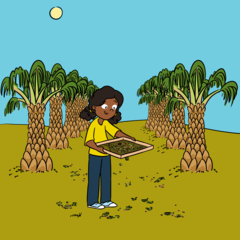
Original illustration of the article in Frontiers for Young Minds (picture: Frontiers for Young Minds).
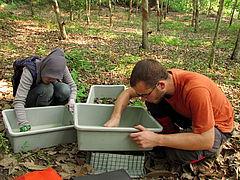
Field assistant Megawati and first author Malte Jochum hand-sorting litter arthropods in a rubber plantation on Sumatra, Indonesia, in 2012 (picture: Andrew D. Barnes).
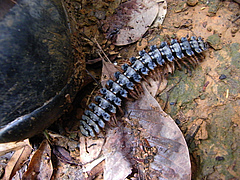
Meet the tropical arthropods – the shoe of researcher Andrew Barnes and a good-sized tropical diplopod that crossed his path in Sumatra’s rainforest remnants (picture: Malte Jochum).
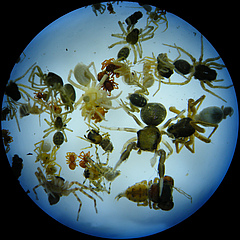
View through a stereomicroscope at a sample of presorted spiders ready to be identified (picture: Malte Jochum).
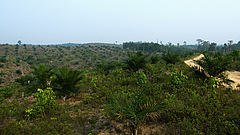
Young oil palms growing on recently cleared land in Sumatra, Indonesia, 2012 (picture: Malte Jochum).
Note for the media: Use of the pictures provided by iDiv is permitted for reports related to this media release only, and under the condition that credit is given to the picture originator.
iDiv scientists explain research on tropical arthropods in journal for young readers
Report by Dr Malte Jochum, postdoctoral researcher at iDiv and Leipzig University and first author of a new publication in Frontiers for Young Minds:
Leipzig. Ground-dwelling arthropod communities in tropical forests are more diverse, have higher numbers (more individuals) and higher biomass than those in nearby plantation systems. We have translated these research results for a young audience and published an article in Frontiers for Young Minds. This journal is committed to making research accessible to kids aged between eight and fifteen, who can also actively take part as reviewers. After all, what is more important than helping kids understand how the world functions and what we can do to help saving it? Tropical ground-dwelling arthropods are threatened by conversion of lowland rainforest into plantations for rubber and palm oil. We published these results in 2014 in Nature Communications and have given several talks and presented posters at scientific conferences since. Also, there was some resonance in the media about our article. However, it has been a while since I last felt as excited about the communication of our results as I am now that we have re-written our scientific article for kids in Frontiers for Young Minds. The journal publishes freely-available articles written by scientists for kids and reviewed by kids together with a science mentor – a researcher or teacher who teams up with a young reviewer to guide them through the review process. Articles are either kid-friendly summaries of published research articles or “core concepts” introducing fundamental ideas for a given field of research. During our joint PhD projects in the EFForTS project, a German-Indonesian research collaboration funded by the DFG, my colleague Andrew Barnes and I found that tropical arthropod communities living in the litter layer of lowland rainforests on Sumatra, Indonesia, were heavily reduced in their number of species (45% decline), number of individuals per area (48% decline) and biomass (52% decline) when these forests were converted into oil-palm plantations. Over the last months, we set some time aside to translate our research findings into a language understandable for kids and created figures visualizing the decline in a simple, intuitive way. For me, writing this article for kids was a very exciting and refreshing experience. As a scientist, I took this as a valuable training exercise in communicating my results to the general public and in a form that can be understood by everyone. It meant taking a step back and looking at my research with an outside perspective asking myself questions like “Why am I even doing this?”, “What good is my research for anyone outside my research bubble?”, or “Why should we care about tropical arthropods and how to explain this to a kid who does not live in or might never visit the tropics?”. I really enjoyed the interactive review process answering the questions of a curious young mind who challenged my mindset of why my research is important or what is the most exciting result of our article. “How long did it take to gather all the data?”, “What is a biodiversity hotspot?”, “What is an arthropod?”, “How was your interaction with the native people of Sumatra?”, questions like these were fun to answer and set my own view of my research into a broader perspective of what others might think or find fascinating about it. If you are a curious young mind between eight and fifteen, a parent looking for a fun read and food for thought for your teenager, or a teacher looking for an interesting article to read in your science or English class, you should have a look at Frontiers for Young Minds. There is also the possibility to sign up as a science mentor. As a researcher interested in science communication, publishing in this journal may help you to once and for all explain to your grandparents, parents, siblings or kids what it is you are working on in your science ivory tower. If you manage to translate your research in an entertaining manner, you can bring an article home for Christmas that will set an end to the never-ending “What is it you are doing there in Indonesia? I don’t understand what’s so fascinating about cockroaches living in-between dead leaves at the other end of the world.”Malte JochumOriginal publication in Frontiers for Young Minds:
(iDiv-affiliated author in bold) Jochum M and Barnes AD (2018) Is Arthropod Biodiversity on the Rainforest Floor Threatened by Rubber and Palm-Oil Plantations? Frontiers for Young Minds 6:72. doi: 10.3389/frym.2018.00072Preceding research article in Nature Communications:
(iDiv- affiliated authors in bold) Barnes, A. D., Jochum, M., Mumme, S., Haneda, N. F., Farajallah, A., Widarto, T. H., Brose, U. (2014) Consequences of tropical land use for multitrophic biodiversity and ecosystem functioning. Nature Communications 5:5351. doi: 10.1038/ncomms6351Further information: EFForTS project:
https://www.uni-goettingen.de/en/310995.html Press release about original research article (University of Göttingen, 31.10.2014, German only):
https://www.uni-goettingen.de/de/3240.html?archive=true&archive_id=4957&archive_source=presseContact:Dr Malte Jochum
Postdoctoral researcher at the research group Experimental Interaction Ecology
German Centre for Integrative Biodiversity Research (iDiv) Halle-Jena-Leipzig
Leipzig University
Email: malte.jochum@idiv.de
Tel.: +49 341 9733173
Web: https://www.idiv.de/groups_and_people/employees/details/eshow/jochum_malte.htmlDr Tabea Turrini
Media and Communications
German Centre for Integrative Biodiversity Research (iDiv) Halle-Jena-Leipzig
Tel.: +49 341 9733106
Email: tabea.turrini@idiv.de
